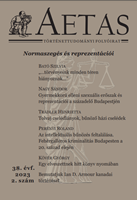Az intellektuális bűnözés feltalálása. Fehérgalléros kriminalitás Budapesten a 20. század elején
The Invention of Intellectual Property Crime. White-Collar Crimes in Budapest at the Beginning of 20th Century
Author(s): Roland PerényiSubject(s): Cultural history, History of Law, Pre-WW I & WW I (1900 -1919), Interwar Period (1920 - 1939), Sociology of Education, Sociology of Law
Published by: AETAS Könyv- és Lapkiadó Egyesület
Keywords: Intellectual Property Crime; White-Collar Crimes; Budapest;
Summary/Abstract: This paper examines the process during which Hungarian society „invented” the category of intellectual property crimes at the turn of the 19th and 20th century. Since the rapidly urbanizing capital was at this time the economic and financial center of the country, the focus of this investigation is Budapest. The effort to define intellectual property crimes can be identified in criminal law, criminology, and in public opinion as well. At the turn of the 19th and 20th centuries, the development of modern capitalist economy and bourgeois society happened extremely quickly in Hungary, so the modern forms of crime closely related to the process – including intellectual property crimes – were codified in the criminal law in response to this, in the framework of a longer process. From the sources available from the turn of the century, it is clear that crimes of an intellectual nature had already appeared in Hungary in the early period of the Austro-Hungarian Monarchy, but they only became really „visible” from the early 1900s. Then, as a result of the First World War and the social and economic crisis following the defeat, the number of white-collar criminals increased by leaps and bounds. Accordingly, from the 1920s onwards, the issue of intellectual property crime became a defining topic in both police and press discourse. While the amount of economic or financial crimes committed by white-collar people increased significantly in the early 1920s and then during the Great Depression, their quantity and the types of crimes also changed continuously, adapting to changes in the economic environment.
Journal: AETAS - Történettudományi folyóirat
- Issue Year: 2023
- Issue No: 2
- Page Range: 80-97
- Page Count: 18
- Language: Hungarian

